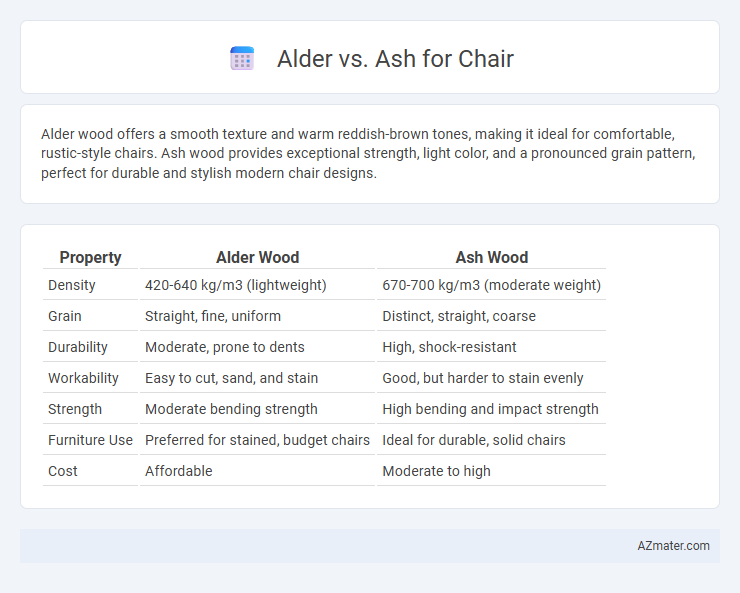Alder wood offers a smooth texture and warm reddish-brown tones, making it ideal for comfortable, rustic-style chairs. Ash wood provides exceptional strength, light color, and a pronounced grain pattern, perfect for durable and stylish modern chair designs.
Table of Comparison
| Property | Alder Wood | Ash Wood |
|---|---|---|
| Density | 420-640 kg/m3 (lightweight) | 670-700 kg/m3 (moderate weight) |
| Grain | Straight, fine, uniform | Distinct, straight, coarse |
| Durability | Moderate, prone to dents | High, shock-resistant |
| Workability | Easy to cut, sand, and stain | Good, but harder to stain evenly |
| Strength | Moderate bending strength | High bending and impact strength |
| Furniture Use | Preferred for stained, budget chairs | Ideal for durable, solid chairs |
| Cost | Affordable | Moderate to high |
Introduction to Alder and Ash Wood
Alder wood is a lightweight and soft hardwood known for its fine grain and uniform texture, making it ideal for chair crafting that requires smooth finishes and easy workability. Ash wood is slightly harder and more durable, featuring a pronounced grain pattern and excellent shock resistance, which contributes to the strength and longevity of chairs made from it. Both Alder and Ash offer distinct aesthetic and structural qualities, with Alder providing warmth and Ash delivering robustness for furniture applications.
Key Differences Between Alder and Ash
Alder wood is softer and more lightweight compared to ash, making it easier to carve and shape for detailed chair designs. Ash wood is harder and more durable, offering superior shock resistance and longevity, ideal for high-traffic seating. The natural grain of ash features pronounced, straight patterns, while alder has a smoother, more uniform texture that takes stain evenly for customizable finishes.
Appearance and Grain Patterns
Alder wood exhibits a smooth, fine grain with a light brown to reddish hue, creating a warm and uniform appearance ideal for chairs that emphasize subtle elegance. Ash features a more pronounced and distinct grain pattern with a pale blonde color, offering a striking and dynamic look that highlights natural wood variations. Both woods provide durable options but differ visually, with alder delivering a softer, consistent texture and ash showcasing bold, contrasting grain lines.
Strength and Durability Comparison
Alder wood is softer and less dense than ash, making it more prone to dents and scratches but easier to work with in chair construction. Ash is known for its superior strength and shock resistance, providing greater durability and longevity in furniture subjected to regular use. Choosing ash for chairs ensures enhanced structural integrity and resilience compared to alder, ideal for heavy-duty applications.
Weight and Workability
Alder wood is lightweight, averaging around 26 pounds per cubic foot, making it easier to handle during chair construction. Ash wood is heavier, approximately 46 pounds per cubic foot, offering greater durability but requiring more effort to work with. Both woods have excellent workability; alder machines smoothly and sands well, whereas ash is known for its strength and flexibility, making it ideal for intricate chair designs.
Comfort and Ergonomics in Chair Making
Alder wood offers a softer, more flexible feel that enhances comfort in chair making, adapting well to ergonomic designs requiring slight cushioning and contouring. Ash wood, known for its strength and resilience, provides superior support and durability, making it ideal for chairs designed for long-term ergonomic stability. Both woods are valued for their ability to balance structural integrity with user comfort in ergonomic chair construction.
Finishing and Staining Qualities
Alder wood offers a smooth, consistent grain that readily absorbs stains, producing a rich, warm finish ideal for various chair designs. Ash features a more pronounced grain with high density, allowing for a durable and striking stain that highlights natural patterns without easily blotching. Both woods respond well to finishing, but Alder's softness enables easier sanding and uniform staining, while Ash provides enhanced resilience and longevity in finished chairs.
Cost and Availability
Alder wood is generally more affordable and widely available compared to Ash, making it a popular choice for chair manufacturing on a budget. Ash is typically pricier due to its strength and durability, often sourced from regions with limited supply, which can affect availability. Both woods offer good workability, but cost and ease of procurement heavily favor Alder for cost-conscious projects.
Environmental Impact and Sustainability
Alder wood is generally more sustainable than ash due to faster growth rates and higher availability, reducing deforestation pressure. Ash, while durable and strong for chair construction, often comes from slower-growing trees, leading to increased environmental impact when harvested unsustainably. Both woods can be eco-friendly choices if sourced from certified sustainable forests, but alder's rapid regeneration offers a significant advantage in reducing carbon footprint and conserving biodiversity.
Which Wood is Best for Your Chair?
Alder wood offers a smooth texture and consistent grain, making it ideal for crafting chairs that require a polished finish and easy staining, while ash provides higher durability and excellent shock resistance, perfect for chairs subjected to heavy use. Ash's natural light color and prominent grain pattern add aesthetic appeal and strength, whereas alder's softer nature makes it easier to work with but less resistant to dents and wear. For long-lasting, sturdy chairs, ash is best; for budget-friendly, easily customizable options, alder is preferable.

Infographic: Alder vs Ash for Chair
 azmater.com
azmater.com